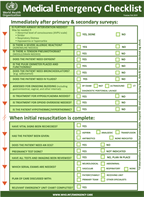Emergency care
All around the world, acutely ill and injured people seek care every day. Frontline providers manage children and adults with medical, surgical and obstetric emergencies, including injuries and infections, heart attacks and strokes, asthma and acute complications of pregnancy. Prioritising an integrated approach to early recognition and resuscitation reduces the impact of all of these conditions.
WHO's Emergency, Trauma and Acute Care programme is dedicated to strengthening the emergency care systems that serve as the first point of contact with the health system for so much of the world, and to supporting the development of quality, timely emergency care accessible to all.
Emergency Care is an essential part of the health system and serves as the first point of contact for many around the world.
Especially when there are logistical or financial barriers to healthcare access, people may present for care only when symptomatic with acute illness or injury. In most cases, the ill and injured present to frontline providers responsible for the care of both children and adults with medical, surgical and obstetric emergencies, including injuries, communicable and noncommunicable diseases, and complications of pregnancy.
Prioritizing an integrated approach to early recognition and resuscitation substantially reduces the morbidity and mortality associated with all of these conditions.
Prehospital and facility-based emergency care is a high impact and cost-effective form of secondary prevention. Additionally, disease surveillance at facilities delivering emergency care is essential to guide primary prevention and outbreak response.
The Disease Control Priorities project estimates that nearly half of deaths and over a third of disability in low and middle income countries could be addressed by the implementation of effective emergency care. The World Health Assembly has called on Member States to prioritise the establishment of integrated emergency and trauma care systems.
Emergency, trauma and acute care services are an essential part of universal health coverage. WHO is dedicated to achieving universal access to emergency care for all persons.












